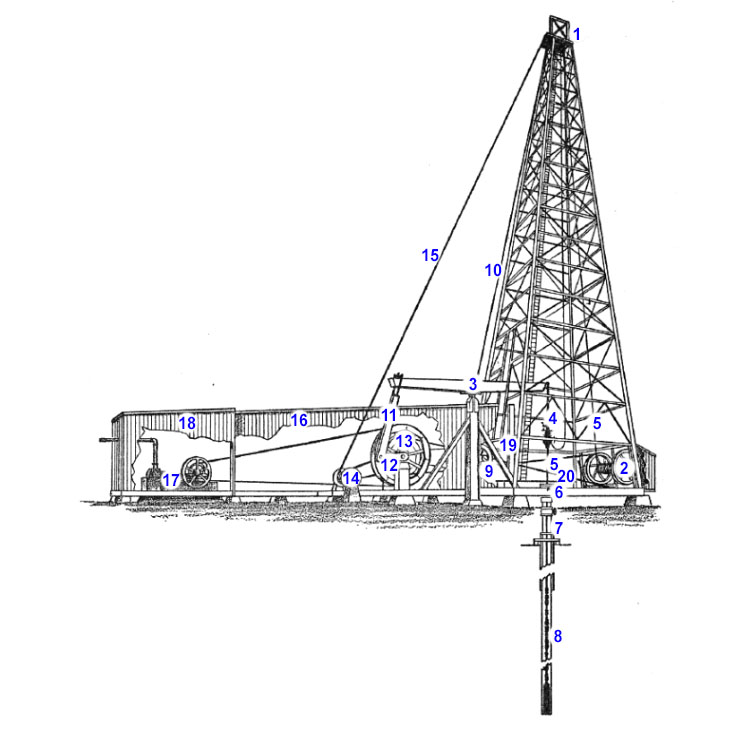HOW THE Cable Tool Drilling Rig WORKS
the Cable Tool Drilling Rig
(from The Fascinating Oil Business)

Cable-tool drilling is done by raising and dropping a string of tools on the end of a cable. The up and down motion is imparted by the walking beam. The tools are pulled from or lowered into the hole by winding or unwinding the drill cable on the bull wheel. Casing is raised or lowered by the casing line and calf wheel. The cuttings are removed from the hole by the bailer, which is raised and lowered by the sand line and reel.
Image Index
- Crown Block
- Bull Wheel
- Walking Beam
- Temper Screw
- Drilling Line
- Casing Head
- Cellar
- Drilling Tools
- Calf Wheel
- Casing Line
- Pittman
- Crank
- Band Wheel
- Sand Reel
- Sand or Bailing Line
- Belt House
- Engine
- Engine House
- Headache Post
- Lazy Bench
Peter McEwan used a cable tool drilling rig for the first time in 1865 when he drilled for oil in Maitlandville.
A vertical beam sits on the cable tool drilling rig’s platform. On top of that sits a horizontal beam that’s like a rocker arm. It’s called a walking beam. As the beam goes up and down, it lifts and drops the cable and bit suspended from the derrick. The calf wheel for the casing line and the sand reel for the bailer also sit on the platform.
The drilling line cable has one end wrapped around a spool so it can be wound and unwound, and the other end attached to a string of tools. At the end of that string is the drill bit shaped like a chisel. When the drilling line cable drops the tool string, the drill bit plunges into the earth. The rock at the bottom of the borehole shatters when the drill bit makes contact.
The bailing line cable operates the bailer. When enough pulverized rock fragments, or drill cuttings, have accumulated at the bottom of the hole, they have to be removed. If they weren’t taken out, they’d be in the way of the drill bit, and it couldn’t do its job. If there’s water in the borehole, that’s good for bailing, but if there’s not, water has to be added to form a slurry with the crushed rock.
When the bailer goes down into the slurry, it has a trapdoor on the bottom that opens. When the bailer is lifted back up, the trapdoor automatically closes. Then the bailer is raised, and the cuttings are dumped into a pit beside the derrick. Depending on the kind of rock encountered, the drill tools must be lifted out of the hole and the bailer sent down about every two hours.
The casing cable is for inserting the casing in the hole to help prevent cave-ins.
Reviews
Get Your Copy Today!
The Salt Man is now available from:
Bayfield
The Village BookShop
24 Main Street North
Bayfield, Ontario N0M 1G0Goderich
Fincher’s
16 Courthouse Square
Goderich, On. N7A 1M8Kincardine
Fincher’s816 Queen Street,Kincardine, On N2Z 2Y2London
Oxford Book Shop Ltd.262 Picadilly StreetLondon, On N6A 1S4Tuckey Home Hardware136 Wortley RoadLondon, On N6C 3P5Bookmarks the Spot
22541 Adelaide Rd
Mount Brydges, ON N0L 1W0Mitchell
Christian Resource Centre29 Ontario Rd, Mitchell, ON N0K 1N0Petrolia
Petrolia Mercantile & Tea419 Petrolia Line, Petrolia, On N0N 1G0Sarnia
The Book Keeper
500 Exmouth Street
Sarnia, On. N7T 5P4Stratford
Fanfare Books92 Ontario Street
Stratford, ON N0H 3H2
Contact Anne Kay
If you have questions about the book or would like to share something with Anne Kay relating to her writing, please complete our contact form.

